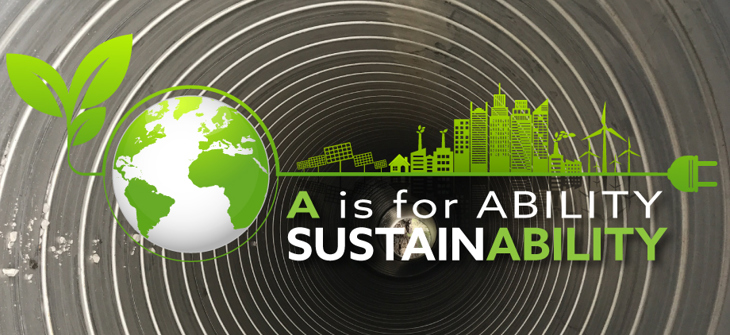
A is for Ability
Important Product Considerations
As you make decisions as an engineering professional or owner, you are always reviewing a product’s ability to perform. How many of these abilities do you think about? Durability, reliability, adaptability, but what about sustainability? Sustainability has heightened attention from all aspects of the design process, and it is necessary to make good decisions today that will not compromise the ability of future generations.
Everywhere you turn there is a heightened awareness on making sustainable choices. The other day, I went to buy a tote bag on the internet and was amazed at all the conscious decisions the company was making to protect the environment when manufacturing their bags. Honestly, on previous purchases, I have not thought about environmental impacts as I probably should have. I know I can do a better job, personally, to protect the environment, but professionally, I am happy to report I work with one of the most recycled materials in the world – STEEL.
As you may be working from home, helping your child with on-line academia or trying to keep the dog from barking during your 5th virtual meeting today, you may not have additional bandwidth to research the sustainability of corrugated steel pipe. Let me help you investigate some new areas and reassure you about steel pipe sustainability.
Let’s use a simple Life Cycle to guide us:
RESOURCE ACQUISITION / PRODUCTION
Typically, resource acquisition and production would be considered two separate bullets. However, as steel is 100% recyclable, it is a part of both the resource allocation and production story. Using these recycled materials in production reduces the consumption of natural ores, water and energy resources.
Corrugated pipe steel is produced using the EAF method, Electric Arc Furnace, the main component is recycled material. An important fact is that recycled steel maintains its internal strength. This material can keep on giving from cradle to end of service, again and again.
Also, there is very little waste with 96% of steel by-product being reused or recycled.
DISTRIBUTION
Corrugated metal pipe can be stacked and nested for distribution efficiencies. It can be hauled with a truck or put on a train, or in some cases it can be manufactured on site.
USE
As engineers and owners, you look at service life as a factor in your decision making. Hopefully you are aware of the vast improvements to coatings in the past decades that are extending the service life of corrugated steel pipe. In many applications, the pipe can last a century or longer. NCSPA Service Life Calculator https://ncspa.org/resources/calculators-charts-tools/service-life-calculator/
On Construction sites, corrugated metal pipe can be used as temporary pipe and returned to the recycle stream versus the waste stream.
While the idea of sustainability and conservatism is a relatively recent “trend” … sustainability is an ability that corrugated metal pipe has had for decades.
END OF LIFE
Due to its magnetic properties, steel is easy to extract.
Steel is the most recycled material on the planet, as more steel is recycled each year than paper, aluminum, plastic and glass combined. According to the Steel Recycling Institute of North America, the recycling rate of steel has reached well over 80 percent.
Sustainability is a story told from a snapshot in time. Steel has had a strong message to tell in regard to this ability, and producers are putting focus and tools together to help clarify the details.
Source: capitalsteel.net, steelsustainability.org
If you’re interested in researching this further, here are a few other links that are very informative:
- AK Steel Recycling https://www.aksteel.com/about-us/corporate-citizenship/sustainability
- NCSPA Sustainability https://ncspa.org/sustainability
